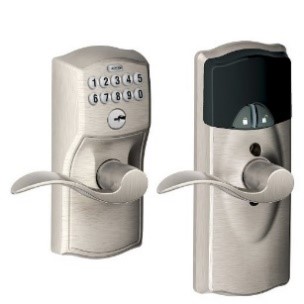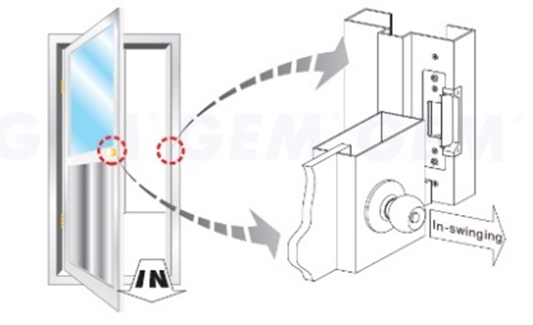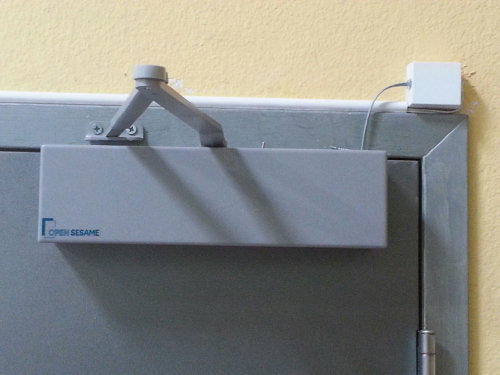By Kirby Smith
The ability to come and go as you please from your own home is not one to take for granted. When you live with muscle weakness, a physical disability, or perhaps as you age, the seemingly simple task of opening and closing your front door may be difficult. Struggling with this everyday function can be a significant barrier to independence. Beyond the front door, interior doors can pose an equal challenge, making a trip to the bathroom or bedroom unnecessarily burdensome. However, new technology is making automatic door openers more available and often more affordable for those who would benefit.
How Automatic Door Openers Work
Let’s start by understanding how these openers work. Automatic door openers can be operated in a variety of ways, including through voice control, a motion sensor, the press of a switch stationed on a wall or stand, an app on a smart device, or a fob that opens the door at the press of a button or when the fob is near the door.
For an automatic door to be reliable, it should be operational even if the electrical power fails. One designed specifically for individuals with disabilities takes this into account and operates off an internal battery. The units are always plugged in to keep the unit charged, but they use the battery to operate.
Automatic door opener systems have five key parts:
1. The Door – The door is part of a frame and when a door is installed, especially a front door, they are installed together. Most homes use wooden doors, however, metal doors and frames are becoming more popular in homes built in recent years.

2. The Lock and Knob – For those who are living with a disability, or have difficulty manipulating keys and knobs, the issue of the door lock is solved with the automated door. A door is locked when the bolt extends from the lock on the door into the opening on the frame. However, the automatic door gets around this by replacing the hole in the frame with an automatic latch. To further automate the door and control access, a smart lock can be added, which eliminates keys. Visitors are given a code to enter on a keypad that can be deleted if you no longer want to grant access (such as when a caregiver no longer works for the person). Remotely, one can unlock the door for someone using a smart device, and smart locks can be controlled from within the home using one’s voice.
3. The Door Operator Unit – This part is attached to the door and does the actual work. It will release and open a locked (or unlocked) door, pause to hold the door open for entrance or exit, close automatically, and then return the door to being locked. A good automatic door opener should give you the option to extend the time the door is open, and allow the door to be closed by pushing the remote control again. Also, I highly recommend units that leaves the door free-swinging for manual use.

4. The Automatic Strike (latch hole) – An important part that works with the door operator unit is the automatic strike. The way a door usually locks is by a bolt in the body of the door extending our and entering the latch hole in the door frame. This keeps the door from being opened. With an automated door, instead of the bolt being activated to unlock the door, an automatic latch hole, called a strike, opens on one side so that the lock bolt no longer catches on it, and the door can swing open without resistance. The automatic strike (latch hole) must be installed into the door frame. This involves cutting into the frame to add the mechanical parts and replace the standard the latch hole. The latch is then attached to the automatic door opener with a thin wire run through the frame.
5. The Remote Control – This is the electronic key. The remote control can be either handheld or easily mounted on a wheelchair. This high-powered remote device can activate the door system from anywhere in the home or a short distance outside of the front door, and many can be activated with fingers, palm, the side of the hand and more. Not all automatic door openers have a physical fob, some are activated by voice, motion, or from a smart device.
Most of us are familiar with industrial and commercial automatic door openers, such as the automatic doors at many supermarkets. These units are usually designed to handle a great deal of traffic and must be built to take a beating. However, these units are very expensive, large, and require special entry ways. Private and home door openers are specifically designed to work within a home and are adapted to function in smaller spaces. They can be installed in just about any door in a home, small business or office.
My Personal Automatic Door Opener Setup

I have installed a lot of automatic doors, and I particularly prefer Open Sesame Door systems. Their automatic door openers are specifically made for people using wheelchairs and those with reduced mobility.
The unit is a little over a foot wide and only requires four screw points to be attached: two at the very top of the door and two where the swing arm is anchored. The unit is not noisy, and it comes in various colors to match the paint on a door, making it less noticeable. It is low voltage and requires little to no maintenance. My wife uses a wheelchair and for the past five years, our door opener has operated reliably every time. The only maintenance ever required was that once I had to tighten the screw on the swing arm. When the door is opened manually, the unit remains off and the door opens freely and swings normally. When engaged, the unit unlatches a locked door, then opens, pauses, and closes it – all automatically. Note: Open Sesame does not lock or unlock your door hardware. Meaning, your regular lock remains locked, and the automatic strike (latch hole) opens to allow the bolt on the lock to swing out. This way the automatic opener can open the door without the use of physical keys or turning a knob. A critical safety feature for Open Sesame Doors is that if the door is closing, and the person or object is still in the doorway and stops its progress, the door will swing back open, pause, and then try to close again. This is important if someone is coming through the door and experiences a problem halfway through, such as the wheelchair getting stuck.
Open Sesame Door Openers have solved many issues related to residential units. However, other automatic door openers have challenging issues that you may want to take into consideration when choosing your door opener, including:
- Reliability – Many of these units have high failure rates. For example, many do not work well when pushed by a person not using the automated features. Some can be damaged if the person entering the door bumps the door while it is opening. If a person is using a wheelchair, this is going to be a likely occurrence. This can cause grinding in the motor and cause it not to work properly over time. Also, some units are under-powered and cannot properly handle the weight of a door,therefore leading to failure. Other units lack independent power, and in the event of a power outage they can cease working entirely.
- Installation – Some units only work with specific door frames, resulting in a modification or total replacement of the door and frame in order to use that unit. Most openers require a power source (nearby outlet or power line installed specifically for the door), and some units require higher voltage requiring an electrician to run a special line for the unit to be able to draw enough power to open the door.
- Noise – Many of these units can be very noisy when functioning. The sound is often described as a loud grinding sound.
Key Takeaways
To recap, here are a few questions to ask yourself when choosing your automatic door opener:
- Does the unit work on battery or will it fail if the power goes out?
- Do you have people coming in and out who will not use the opener? Consider one that will swing freely when opened manually and won’t fail over time if people push on it while it’s operating.
- What is your preference for operating the door? Voice? Motion? The press of a switch mounted somewhere? The use of a fob with a button or that activates the door when in proximity?
- Is it important to you to have the ability to control the door remotely through an app on your phone? Make sure the opener you’re looking at is compatible with the smart device you plan to use.
- Is the door likely to get bumped as you’re moving through the doorway? Read reviews to see how the opener you’re interested in stands up to repeated bumps.

